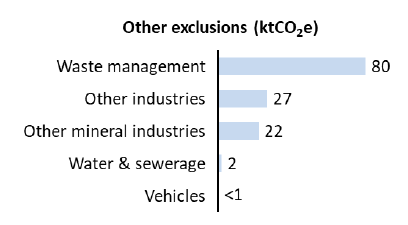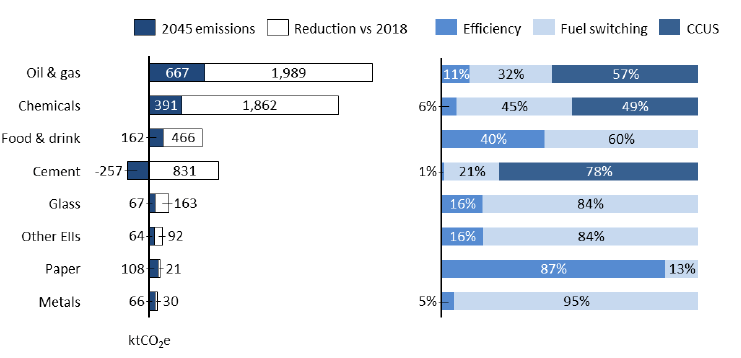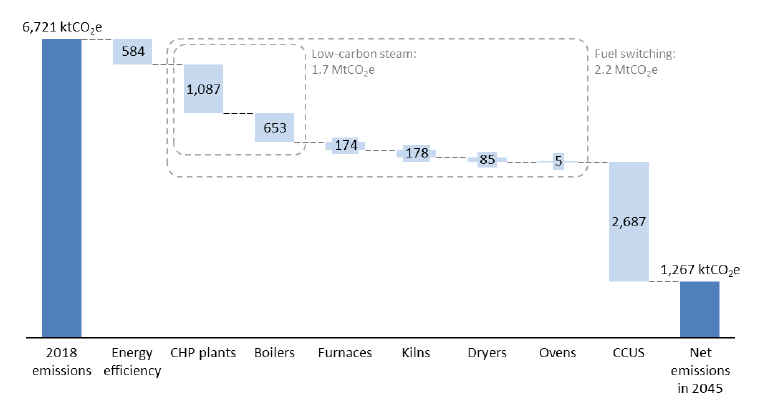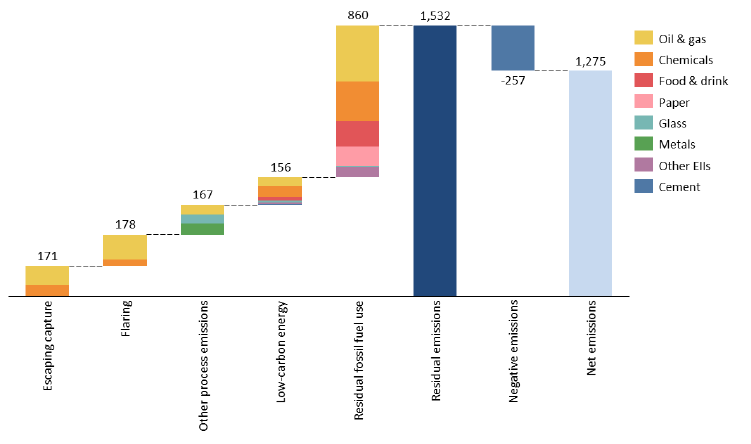Deep decarbonisation pathways for Scottish industries: research report
The following report is a research piece outlining the potential pathways for decarbonisation of Scottish Industries. Two main pathways are considered, hydrogen and electrification, with both resulting in similar costs and levels of carbon reduction.
8 Appendix
8.1 Bibliography for the literature review
Benner, J., van Lieshout, M., & Croezen, H. (2011). Identifying breakthrough technologies for the production of basic chemicals. https://www.scribd.com/document/342182520/CE-Delft-Identifying-Breakthrough-Technologies-for-the-Production-of-Basic-Chemicals.
British Glass. (2014). A Clear Future: UK glass manufacturing sector decarbonisation roadmap to 2050. https://www.britglass.org.uk/sites/default/files/A%20clear%20future%20-%20UK%20glass%20manufacturing%20sector%20decarbonisation%20roadmap%20to%202050_summary.pdf.
British Glass. (2017). Recycled content of glass packaging. https://www.britglass.org.uk/knowledge-base/resources-and-publications/recycled-content-glass-packaging.
Brownsort, P. (2018). Negative Emission Technology in Scotland: carbon capture and storage for biogenic CO2 emissions. www.sccs.org.uk/images/expertise/reports/working-papers/WP_SCCS_2018_08_Negative_Emission_Technology_in_Scotland.pdf.
Committee on Climate Change. (2018). Biomass in a low-carbon economy. https://www.theccc.org.uk/publication/biomass-in-a-low-carbon-economy/.
Committee on Climate Change. (2019). Net Zero Technical Report. https://www.theccc.org.uk/publication/biomass-in-a-low-carbon-economy/.
Element Energy, Ecofys, & Imperial College London. (2014). The potential for recovering and using surplus heat from industry. https://www.gov.uk/government/uploads/system/uploads/attachment_data/file/294900/element_energy_et_al_potential_for_recovering_and_using_surplus_heat_from_industry.pdf.
Element Energy, & Jacobs. (2018). Industrial Fuel Switching Market Engagement Study. https://assets.publishing.service.gov.uk/government/uploads/system/uploads/attachment_data/file/824592/industrial-fuel-switching.pdf.
Element Energy, Advisian, & Cardiff University. (2019). Hy4Heat WP6: Conversion of Industrial Heating Equipment to Hydrogen. https://www.hy4heat.info/reports.
Energy Transitions Commission. (2018). Mission Possible: Reaching net-zero carbon emissions from harder-to-abate sectors by mid-century. http://www.energy-transitions.org/mission-possible.
Griffin, P. W., Hammond, G. P., & Norman, J. B. (2018). Industrial energy use and carbon emissions reduction in the chemicals sector: A UK perspective. Applied Energy, 227, 587–602. https://www.sciencedirect.com/science/article/pii/S0306261917310255?via%3Dihub.
ICF Consulting Services Limited, & Fraunhofer ISI. (2019). Industrial Innovation: Pathways to deep decarbonisation of Industry. Part 1: Technology Analysis. https://ec.europa.eu/clima/sites/clima/files/strategies/2050/docs/industrial_innovation_part_1_en.pdf.
IEA, ICCA, & DECHEMA. (2013). Technology Roadmap Energy and GHG Reductions in the Chemical Industry via Catalytic Processes. https://webstore.iea.org/technology-roadmap-energy-and-ghg-reductions-in-the-chemical-industry-via-catalytic-processes.
Lenaghan, M., & Mill, D. (2015). Industrial Decarbonisation and Energy Efficiency Roadmaps: Scottish Assessment. https://www.theccc.org.uk/2015/03/27/industrial-decarbonisation-and-energy-efficiency-roadmaps-to-2050/.
Mineral Products Association. (2013). The UK cement industry 2050 roadmap. www.sccs.org.uk/images/expertise/reports/working-papers/WP_SCCS_2018_08_Negative_Emission_Technology_in_Scotland.pdf.
WSP Parson Brinkerhoff, & DNV GL. (2015). Industrial Decarbonisation and Energy Efficiency Roadmaps to 2050. (Note: roadmaps for different sectors)https://www.gov.uk/government/publications/industrial-decarbonisation-and-energy-efficiency-roadmaps-to-2050.
8.2 Other references
ACT Acorn Consortium. (2019). ACT Acorn Feasibility Study: D20 Final Report. actacorn.eu/sites/default/fi les/ACT%20Acorn%20Final%20Report.pdf
Antonini, C., Treyer, K., Streb, A., van der Spek, M., Bauer, C., & Mazzotti, M. (2020). Sustainable Energy & Fuels Hydrogen production from natural gas and biomethane with carbon capture and storage – A techno-environmental analysis. Sustainable Energy Fuels, 4, 2967–2986. https://doi.org/10.1039/d0se00222d.
BEIS. (2018). Updated energy and emissions projections. https://www.gov.uk/government/publications/updated-energy-and-emissions-projections-2018.
BEIS. (2020). Renewable electricity in Scotland, Wales, Northern Ireland and the regions of England, Energy Trends. https://assets.publishing.service.gov.uk/government/uploads/system/uploads/attachment_data/file/875409/ET_6.1.xls.
Bloomberg NEF. (2020). Hydrogen Economy Outlook. https://about.bnef.com/blog/hydrogen-economy-offers-promising-path-to-decarbonization/.
Bossel, U., Eliasson, B. (2003) Energy and The Hydrogen Economy. http://www.methanol.org/pdf/HydrogenEconomyReport2003.pdf.
Committee on Climate Change. (2017). Energy Prices and Bills. https://www.theccc.org.uk/publication/energy-prices-and-bills-report-2017/.
Committee on Climate Change. (2018). Reducing UK emissions: 2018 Progress Report to Parliament. https://www.theccc.org.uk/wp-content/uploads/2018/06/CCC-2018-Progress-Report-to-Parliament.pdf
Committee on Climate Change. (2019). Reducing emissions in Scotland 2019 Progress Report to Parliament. https://www.theccc.org.uk/wp-content/uploads/2019/12/Reducing-emissions-in-Scotland-2019-Progress-Report-to-Parliament-CCC.pdf
E4Tech. (2019). H2 emissions potential: literature review. https://assets.publishing.service.gov.uk/government/uploads/system/uploads/attachment_data/file/798243/H2_Emission_Potential_Report_BEIS_E4tech.pdf.
Element Energy, Carbon Counts, PSE, Imperial College, & University of Sheffield. (2014). Demonstrating CO2 capture in the UK cement, chemicals, iron and steel and oil refining sectors by 2025: a techno-economic study. http://www.element-energy.co.uk/wordpress/wp-content/uploads/2017/06/Element_Energy_DECC_BIS_Industrial_CCS_and_CCU_final_report_14052014.pdf.
Element Energy. (2017a). Deployment of an industrial Carbon Capture and Storage cluster in Europe: A funding pathway. https://www.i2-4c.eu/wp-content/uploads/2017/10/i24c-report-Deployment-of-an-industrial-CCS-cluster-in-Europe-2017-Final-.pdf
Element Energy. (2017b). Enabling the deployment of industrial CCS. https://ieaghg.org/publications/technical-reports/reports-list/9-technical-reports/960-2018-01-enabling-the-deployment-of-industrial-ccs-clusters.
Element Energy. (2018). Industrial carbon capture business models. https://assets.publishing.service.gov.uk/government/uploads/system/uploads/attachment_data/file/759286/BEIS_CCS_business_models.pdf.
Element Energy. (2019a). Assessment of Options to Reduce Emissions from Fossil Fuel Production and Fugitive Emissions. https://www.theccc.org.uk/publication/assessment-of-options-to-reduce-emissions-from-fossil-fuel-production-and-fugitive-emissions/.
Element Energy. (2019b). Hy-Impact Series Hydrogen in the UK, from technical to economic. A summary of four studies assessing the role of hydrogen in the UK net-zero transition. http://www.element-energy.co.uk/wordpress/wp-content/uploads/2019/11/Element-Energy-Hy-Impact-Series-Summary-Document.pdf.
Element Energy. (2019c). Extension to Fuel Switching Engagement Study (FSES) – Assumptions log. https://www.theccc.org.uk/publication/extension-to-fuel-switching-engagement-study-deep-decarbonisation-of-uk-industries-assumptions-log/.
Element Energy. (2020). Gigastack: Bulk Supply of Renewable Hydrogen. www.element-energy.co.uk/wordpress/wp-content/uploads/2020/02/Gigastack-Phase-1-Public-Summary.pdf.
Grubb, M. (2014). Planetary Economics: Energy, climate change and the three domains of sustainable development.
Health and Safety Laboratory. (2015). Injecting hydrogen into the gas network – a literature search. https://www.hse.gov.uk/research/rrpdf/rr1047.pdf.
HM Government, & Scottish Government. (2020). The future of UK carbon pricing UK government and devolved administrations' response. https://www.gov.uk/government/consultations/the-future-of-uk-carbon-pricing.
Hydrogen Council. (2020). Path to hydrogen competitiveness: a cost perspective. https://hydrogencouncil.com/en/path-to-hydrogen-competitiveness-a-cost-perspective/.
IEAGHG. (2019). Towards zero emissions CCS in power plants using higher capture rates or biomass. (March), 1–128. http://documents.ieaghg.org/index.php/s/CLIZIvBI6OdMFnf/download.
Lenaghan, M., & Mill, D. (2015). Industrial Decarbonisation and Energy Efficiency Roadmaps: Scottish Assessment. https://www.resourceefficientscotland.com/sites/default/files/downloadable-files/Industrial%20Decarbonisation%20and%20Energy%20Efficiency%20Roadmaps%20Scottish%20Assessment.pdf.
Mohd S., Hendrik, J., Cloete, S., & Amini, S. (2019). Efficient hydrogen production with CO2 capture using gas switching reforming. Energy, 185, 372–385. https://doi.org/10.1016/j.energy.2019.07.072.
Navigant for the Energy Networks Association. (2020). Pathways to Net-Zero: Decarbonising the Gas Networks in Great Britain. https://www.energynetworks.org/assets/files/gas/Navigant%20Pathways%20to%20Net-Zero.pdf.
NAEI (2019) Greenhouse Gas Inventories for England, Scotland, Wales & Northern Ireland: 1990-2017. https://naei.beis.gov.uk/reports/reports?report_id=1000.
Owen, A., Ivanova, D., Barrett, J., Cornelius, S., Francis, A., Matheson, S., Redmond- King, G., & Young, L. (2020). Carbon Footprint: Exploring the UK’s Contribution to Climate Change. https://www.wwf.org.uk/sites/default/files/2020-04/FINAL-WWF-UK_Carbon_Footprint_Analysis_Report_March_2020%20%28003%29.pdf
Parsons Brinckerhoff. (2011). Electricity Generation Cost Model - 2011 Update - Revision 1. https://www.gov.uk/government/uploads/system/uploads/attachment_data/file/48126/2153-electricity-generation-cost-model-2011.pdf.
Pale Blue Dot. (2018). CO2 Transportation and Storage Business Models. https://www.gov.uk/government/uploads/system/uploads/attachment_data/file/677721/10251BEIS_CO2_TS_Business_Models_FINAL.pdf.
Pale Blue Dot and Axis Well Technology. (2016). Progressing Development of the UK's Strategic Carbon Dioxide Storage Resource A Summary of Results from the Strategic UK CO2 Storage Appraisal Project. https://www.eti.co.uk/programmes/carbon-capture-storage/strategic-uk-ccs-storage-appraisal.
Ricardo. (2018). Whisky by-products in renewable energy. https://www.climatexchange.org.uk/media/3024/revised-february-2018-whisky-by-products-life-cycle-analysis-report-v02-03.pdf.
Ricardo. (2019). Zero Emission HGV Infrastructure Requirements. https://www.theccc.org.uk/publication/zero-emission-hgv-infrastructure-requirements/.
Ricardo. (2020). Scotch whisky pathway to net zero. https://www.scotch-whisky.org.uk/media/1733/net-zero-pathways-report-june-2020.pdf
Rosenbloom, D., Markard, J., Geels, F. W., & Fuenfschilling, L. (2020). Why carbon pricing is not sufficient to mitigate climate change—and how "sustainability transition policy" can help. Proceedings of the National Academy of Sciences of the United States of America, 117(16), 8664–8668. https://doi.org/10.1073/pnas.2004093117.
Scotch Whisky Association. (2012). Scotch Whisky Industry Environmental Strategy Report 2012. http://www.laphroaig.it/files/2012_swa_environmentalstrategy.pdf.
SLR. (2020). Decarbonisation of heat across the food and drink manufacturing sector. https://www.fdf.org.uk/publicgeneral/fdf-slr-report-decarbonising-heat-to-net-zero.pdf.
Speirs, J., Balcombe, P., Johnson, E., Martin, J., Brandon, N., & Hawkes, A. (2017). A Greener Gas Grid: What Are the Options? https://www.sustainablegasinstitute.org/wp-content/uploads/2017/12/SGI-A-greener-gas-grid-what-are-the-options-WP3.pdf
The Scottish Government. (2019). The Scottish Greenhouse Gas Emissions Annual Target Report for 2017. https://www.gov.scot/publications/scottish-greenhouse-gas-emissions-annual-target-report-2017/.
University of Edinburgh. (2009). Opportunities for CO2 Storage around Scotland; An Integrated Strategic Research Study. https://era.ed.ac.uk/handle/1842/15718.
van Cappellen, L., Croezen, H., & Rooijers, F. (2018). Feasibility study into blue hydrogen. https://greet.es.anl.gov/publication-smr_h2_2019.
8.3 Emissions in and out of scope
Table 19 provides a breakdown of all GHG emissions in Scotland in 2018. Out of a total 41.6 MtCO2e, 28% (11.5 MtCO2e) is mapped to the 'Industry' sector (according to mapping for the Climate Change Plan, or CCP).
| CCP Mapping | Source Sector | CO2 (MtCO2e) | Other GHG (MtCO2e) | Total (MtCO2e)[183] |
|---|---|---|---|---|
| Industry | Business and Industrial Process | 6.45 | 0.42 | 6.87 |
| Energy supply | 4.21 | 0.44 | 4.65 | |
| Total Industry | 10.66 | 0.86 | 11.53 | |
| Agriculture | Agriculture and Related Land Use | 1.03 | 6.44 | 7.47 |
| Electricity Generation | Energy Supply | 2.13 | 0.02 | 2.15 |
| Land use | Agriculture and Related Land Use | 1.79 | 0.32 | 2.11 |
| Development | 1.90 | 0.15 | 2.05 | |
| Forestry | -9.67 | 0.08 | -9.59 | |
| Residential | Residential | 6.01 | 0.22 | 6.23 |
| Services | Business and Industrial Process | 1.30 | 0.78 | 2.08 |
| Public Sector Buildings | 1.10 | 0.00 | 1.10 | |
| Transport | International Aviation and Shipping | 1.88 | 0.02 | 1.90 |
| Transport (exc. above) | 12.76 | 0.14 | 12.91 | |
| Waste | Waste Management | 0.01 | 1.67 | 1.68 |
| Total Other | 20.23 | 9.85 | 30.09 | |
| Total Scotland | 30.90 | 10.72 | 41.61 |
Emissions from members of the Scottish Whisky Association
A recent report by Ricardo commissioned by the SWA and covering 127 sites (including 70 malt distilleries, 5 grain distilleries and 11 packaging sites) determined that emissions from these sites amounted to 529 ktCO2e in 2018. Of these, 5% relate to electricity use (scope 2, and hence not in scope), and 198 ktCO2e are from 11 large distilleries already accounted for within the NAEI data. Hence, it was estimated that emissions from the other 116 sites were 305 ktCO2e.
Emissions from smaller sites
A previous report by Zero Waste Scotland indicated that, in 2012, the food and drink subsector included "over 800 companies, only 4% of which […] defined as 'large enterprises'", which collectively generated nearly 1.7 MtCO2e.[184] By comparison, the large food and drink sites included in the NAEI data only reported emissions of 0.3 MtCO2e in 2018, and even including SWA member sites the reported sector total barely exceeded 0.6 MtCO2e in 2018. For this reason, it is believed that a large share of the estimated 1.6 MtCO2e from smaller sites originates within this sector. Further information around possible decarbonisation pathways for the food and drink sectors can be found in a recent report by SLR for the Food and Drink Federation (FDF).[185]
Emissions of greenhouse gas other than CO2
As indicated in Section 2.2, carbon dioxide (CO2) is by far the most commonly emitted greenhouse gas (GHG) across all Scottish industries, contributing to 92% of all global warming potential.[186] There are however a few sources within industries out of scope which emit non-negligible amounts of other GHGs: [187]
- Industrial refrigeration systems, which emit 0.14 MtCO2e of hydrofluorocarbon (HFC) gases.
- Electronics and shoes manufacturing, which emit 0.14 MtCO2e of perfluorinated chemicals (PFCs).
- Foam blowing and fire protection equipment, which also emit a smaller amount of HFCs (0.05 MtCO2e).
- Electrical insulation equipment, from which 0.02 MtCO2e of sulfur hexafluoride (SF6) are emitted yearly.
- Other sources, which combined emit a total of 0.09 MtCO2e.
More substantial emissions of other GHGs occur in the upstream oil and gas operations, where 0.4 MtCO2e of methane (CH4) was emitted in 2018 (see Figure 1).
| All values in MtCO2e | HFCs | PFCs | SF6 | CH4 | N2O | NF3 | Total |
|---|---|---|---|---|---|---|---|
| Industrial Refrigeration | 0.14 | - | - | - | - | - | 0.14 |
| Electronics and shoes | - | 0.13 | 0.01 | - | - | - | 0.14 |
| Firefighting | 0.03 | - | - | - | - | - | 0.03 |
| Foams | 0.02 | - | - | - | - | - | 0.02 |
| Electrical insulation | - | - | 0.02 | - | - | - | 0.02 |
| Other sources | 0.03 | 0.02 | 0.01 | 0.01 | 0.02 | 0.00 | 0.09 |
| Total | 0.22 | 0.14 | 0.04 | 0.01 | 0.02 | 0.00 | 0.43 |
Other exclusions
Figure 18 provides a breakdown of the 0.1 MtCO2e classified as 'other exclusions in Figure 1.

8.4 Sector-specific and cross-sectoral processes
| Emissions source | Sector-specific process | Cross-sectoral processes | Applicable sector or subsector |
|---|---|---|---|
| Boiler or CHP | Drying, separation, space heating, other steam-based processes | Indirect – Steam-driven (from boiler or CHP) | All |
| CHP | Processes driven by electricity | Electricity-driven (from CHP) | |
| Dryer | Drying | Direct - Low Temperature Direct - High Temperature |
Paper, food & drink, other EIIs |
| Fluid catalytic cracker | Fluid catalytic cracking | Direct - High Temperature | Oil and gas refining |
| Cement kiln | Cement kiln | Direct - High Temperature | Cement |
| Natural gas fired furnace | Casting, closed-die forging press, steel finishing, rolling | Direct - High Temperature | Metals |
| Melting | Direct - High Temperature | Glass | |
| Other high-temperature process | Direct - High Temperature Indirect - High Temperature |
Glass, refining, other EIIs | |
| Natural gas oven | Baking and other direct fired processes | Direct - Low Temperature | Food & drink |
| Steam cracker | Steam cracking | Indirect - High Temperature | Olefins |
| Chemical reactions in industrial process | Calcination | Industrial Process | Cement |
| Aluminium electrolysis | Aluminium | ||
| Feedstock degradation | Glass | ||
| Flaring | Olefins, oil and gas refining | ||
| Steam-methane reactor | Oil and gas refining | ||
| Other | Other Direct Fire | Direct - Low Temperature | Food & drink |
| Other | Other | Chemicals, food & drink, other EIIs |
8.5 Emissions by cross-sectoral processes
The tables below report the numerical values of the emissions breakdown shown in Figure 6.
| Cross-sectoral process | Chemicals | Oil & gas | Cement | Other EIIs | Paper | Food & drink | Glass | Metals |
|---|---|---|---|---|---|---|---|---|
| High Temperature | 1,072 | 1,168 | - | - | - | - | - | - |
| Steam from CHP | 444 | 493 | - | 3 | 69 | 9 | - | - |
| Steam from boiler | 453 | - | - | 21 | - | 436 | - | 1 |
| High Temperature | - | 266 | 188 | 56 | - | - | 180 | 32 |
| Low Temperature | - | - | - | 22 | 4 | 69 | - | - |
| Electricity from CHP | 212 | 346 | - | 51 | 57 | 10 | - | - |
| Unclassified fuel use | 35 | - | - | 4 | - | 104 | - | - |
| Process | 37 | 383 | 385 | - | - | - | 50 | 64 |
| Cross-sectoral process | Natural gas | Solid fuels | Oil | Internal fuel | Industrial processes |
|---|---|---|---|---|---|
| High Temperature | 467 | - | - | 1,772 | - |
| Steam from CHP | 1,007 | 4 | 7 | - | 190 |
| Steam from boiler | 765 | 14 | 131 | - | 65 |
| High Temperature | 263 | 193 | 0 | 266 | 14 |
| Low Temperature | 73 | 2 | 20 | - | 269 |
| Electricity from CHP | 676 | - | - | - | 164 |
| Unclassified fuel use | 103 | 3 | 37 | - | - |
| Process | - | - | - | - | 819 |
8.6 Carbon cost assumptions
| Traded | Non-traded | |||||
|---|---|---|---|---|---|---|
| Low | Central | High | Low | Central | High | |
| 2010 | 14 | 14 | 14 | 30 | 60 | 90 |
| 2011 | 13 | 13 | 13 | 30 | 61 | 91 |
| 2012 | 7 | 7 | 7 | 31 | 61 | 92 |
| 2013 | 4 | 4 | 4 | 31 | 62 | 94 |
| 2014 | 5 | 5 | 5 | 32 | 63 | 95 |
| 2015 | 6 | 6 | 6 | 32 | 64 | 96 |
| 2016 | 5 | 5 | 5 | 33 | 65 | 98 |
| 2017 | 5 | 5 | 5 | 33 | 66 | 99 |
| 2018 | 2 | 13 | 26 | 34 | 67 | 101 |
| 2019 | 0 | 13 | 26 | 34 | 68 | 102 |
| 2020 | 0 | 14 | 28 | 35 | 69 | 104 |
| 2021 | 4 | 21 | 37 | 35 | 70 | 106 |
| 2022 | 8 | 27 | 46 | 36 | 72 | 107 |
| 2023 | 12 | 34 | 56 | 36 | 73 | 109 |
| 2024 | 16 | 41 | 65 | 37 | 74 | 111 |
| 2025 | 20 | 47 | 74 | 38 | 75 | 113 |
| 2026 | 24 | 54 | 84 | 38 | 76 | 114 |
| 2027 | 28 | 61 | 93 | 39 | 77 | 116 |
| 2028 | 32 | 67 | 103 | 39 | 79 | 118 |
| 2029 | 36 | 74 | 112 | 40 | 80 | 120 |
| 2030 | 40 | 81 | 121 | 40 | 81 | 121 |
| 2031 | 44 | 88 | 132 | 44 | 88 | 132 |
| 2032 | 48 | 96 | 144 | 48 | 96 | 144 |
| 2033 | 52 | 103 | 155 | 52 | 103 | 155 |
| 2034 | 55 | 111 | 166 | 55 | 111 | 166 |
| 2035 | 59 | 118 | 178 | 59 | 118 | 178 |
| 2036 | 63 | 126 | 189 | 63 | 126 | 189 |
| 2037 | 67 | 133 | 200 | 67 | 133 | 200 |
| 2038 | 70 | 141 | 211 | 70 | 141 | 211 |
| 2039 | 74 | 148 | 223 | 74 | 148 | 223 |
| 2040 | 78 | 156 | 234 | 78 | 156 | 234 |
| 2041 | 82 | 163 | 245 | 82 | 163 | 245 |
| 2042 | 85 | 171 | 256 | 85 | 171 | 256 |
| 2043 | 89 | 178 | 268 | 89 | 178 | 268 |
| 2044 | 93 | 186 | 279 | 93 | 186 | 279 |
| 2045 | 97 | 193 | 290 | 97 | 193 | 290 |
| 2046 | 100 | 201 | 301 | 100 | 201 | 301 |
| 2047 | 104 | 208 | 313 | 104 | 208 | 313 |
| 2048 | 108 | 216 | 324 | 108 | 216 | 324 |
| 2049 | 112 | 223 | 335 | 112 | 223 | 335 |
| 2050 | 115 | 231 | 346 | 115 | 231 | 346 |
Source: BEIS modelling (2019). Further guidance on the use of carbon values is available from the appraisal guidance (Chapter 3) which can be downloaded from the Green Book supplementary guidance section of GOV.UK webpage.
8.7 Modelling assumptions for carbon capture and compression
This section summarises all modelling assumptions for carbon capture and compressor.
Capture costs
The CAPEX for a plant of size X MtCO2/y and with CO2 flue gas concentration Y is given by the following set of formulas:
CAPEX for plant of size X = (CAPEX of reference plant) * (X / reference size) ^ (scaling exponent) *
* (Flue gas concentration of reference plant / Y) ^ (CO2 exponent)
The OPEX is instead calculated as percentage of CAPEX. All the relevant data is provided in the tables below where values for advance amines and calcium looping capture technologies is provided for reference (source: Element Energy, 2019c).
| Subsector | Emission source | Type | CO2 stream purity (% volume) | Assumed capture rate |
|---|---|---|---|---|
| Cement | Calcination reaction | Process | 95% | 100% |
| Cement | Kiln | Combustion | 10% | 90% |
| Petrochemicals | Steam cracking | Combustion | 10% | 90% |
| Refining | Refinery furnaces | Combustion | 10% | 90% |
| Refining | SMR | Process | 95% | 100% |
| Capture technology | Reference CAPEX (£m) | Opex (% of CAPEX) | Reference size (MtCO2/y) | Scaling exponent | Reference CO2 stream purity (% volume) | CO2 exponent |
|---|---|---|---|---|---|---|
| First generation amines | 505.6 | 8% | 2 | 0.67 | 11.5% | 0.53 |
| Advanced amines | 388.9 | 5% | 2 | 0.67 | 11.5% | 0.53 |
| Calcium looping | 155.4 | 19% | 2 | 0.67 | 13.0% | 0.53 |
Energy requirements for capture
The heat and electricity requirements are inversely proportional to the CO2 concentration of the exhaust stream. The formula for the heat input required per tCO2 is given by
Heat input (kWh/tCO2) = Reference heat input * Heat scaling coefficient *
* (CO2 concentration (%) * 100) ^ Heat scaling exponent
The formula for the electricity input required is analogous (swap 'heat' with 'electricity' in the above). All the necessary data is provided in Table 26.
Note that the energy costs are additional to those calculated above for capture and below for compression.
| Capture technology | Reference heat input (kWh/t CO2) | Heat scaling coefficient | Heat scaling exponent | Reference electricity input (kWh/t CO2) | Electricity scaling coefficient | Electricity scaling exponent |
|---|---|---|---|---|---|---|
| First generation amines | 1056 | 1.42 | -0.142 | 56.0 | 11.2 | -0.99 |
| Advanced amines | 833 | 1.42 | -0.142 | 56.0 | 11.2 | -0.99 |
| Calcium looping | 444 | 1.42 | -0.142 | 150.0 | 11.2 | -0.99 |
Compression costs
It is assumed that CO2 is always captured at atmospheric pressure (0.11MPa) and must be compressed to 10MPa for pipeline transport. The compressor is sized according to the following formula:[189]
Compressor size (MW) = CO2 flowrate (m3/s) * 0.11 MPa * log(10MPa/0.11MPa) / Compressor efficiency (%)
Where the CO2 flowrate in m3/s can be calculated from the annual abatement and the (pressure-dependent) density of CO2. The CAPEX and OPEX of the compressor are calculated in an analogous manner to the corresponding capture costs
| Capex (£m/MW) | Opex (% of CAPEX) | Efficiency (%) | Reference size (MW) | Sizing exponent |
|---|---|---|---|---|
| 1.64 | 5% | 75% | 10 | 0.29 |
8.8 Additional results for the Hydrogen pathway
The figures below complement the those for the Hydrogen pathway presented in Chapter 6.



8.9 Capital expenditure: annualised and financing cost
The capital expenditure, CAPEX, is annualised using MS Excel's PMT function:
Annualised CAPEX: -PMT(WACC, [Equipment lifetime], [Equipment CAPEX])
Where WACC is the Weighted Average Cost of Capital, assumed equal to 10% (representative of that for the private sector).
The annualised CAPEX is further split into two components:
Repayment of the principal loan: -PMT(0, [Equipment lifetime], [Equipment CAPEX])
Interest payments: Annualised CAPEX - Principal loan repayment
Avoided carbon costs (through a carbon price) are not included.
The overall (i.e. not levelised) cost of abatement can be calculated using the formula above but setting R = 1 (effectively no discounting).
8.10 Levelised cost of abatement methodology
The levelised cost of abatement (LCOA) represents the carbon price that would be needed to make a given carbon abatement measure economically viable – i.e. achieve a zero net-present value (NPV). The way the LCOA is calculated is similar to that used to calculate the levelised cost of energy,[190] i.e.:
| LCOA (£/tCO2) = | net present cost of measure | = | Σ [ (CAPEX + OPEX + fuel cost difference[191])n / (1 + R)n ] |
| total discounted lifetime abatement | Σ [ (abated emissions)n / (1 + R)n ] |
Where R is the discount rate of 3.5%, n is the period (e.g. n = 1 is 2018 and n = 28 is 2045), and the sums are over all periods from n = 1 to n = 53 (corresponding to 2070).[192] In the calculation for the levelised cost of energy the denominator would be replaced by the discounted sum of the electrical energy produced in period n.
Contact
Email: Michael.Cairns2@gov.scot
There is a problem
Thanks for your feedback